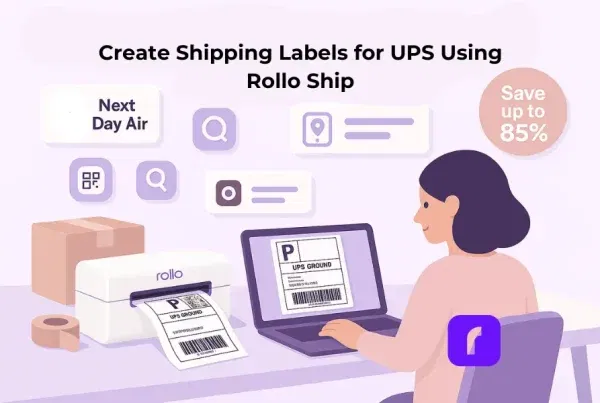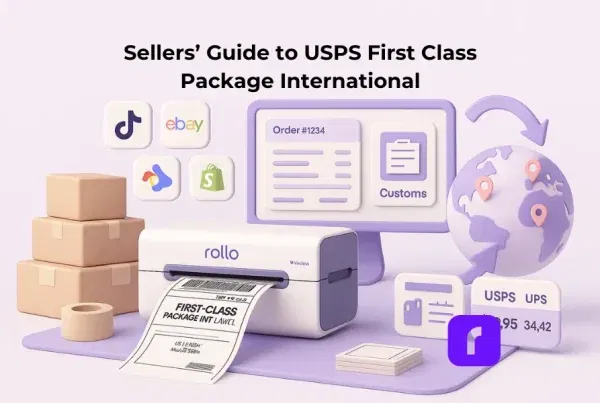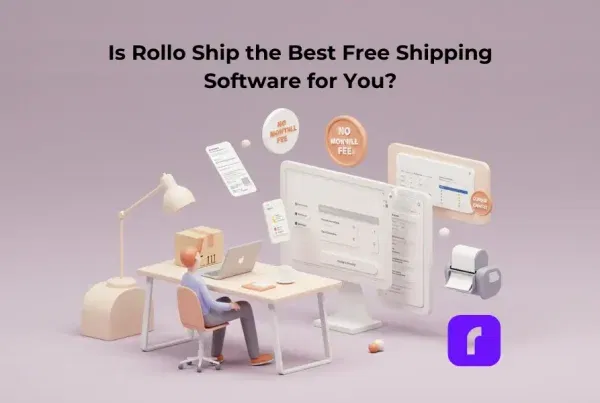Print labels with ease with Rollo’s thermal printer for shipping labels. Learn how using regular inkjet and laser printers compares to a specialized label printer when it comes to shipping labels, brand labels, and barcodes. Unleash your e-commerce potential now!
Table of Contents
The E-Commerce Boom
The “new normal” saw a surge of new e-commerce businesses as people realized their entrepreneurial dreams. Creating websites, building Shopify and Amazon pages, and establishing an online presence is exciting, but eventually, you hit a practical roadblock: how do you ship products to your customers? Can you print shipping labels using a regular printer? The short answer is yes, but there are pros and cons to each option. Understanding these differences can greatly impact your e-commerce success.
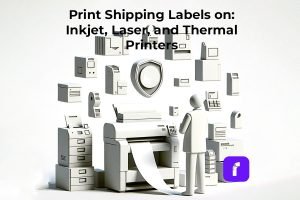
Option 1: Inkjet Printers – The Basic Household Printer
The oldest type of printer used is the inkjet printer. They are common in most households, using ink cartridges to print on regular paper. It’s possible to print shipping labels with an inkjet printer by simply sending a PDF of the label and taping it to your package. However, the lack of specialization means these labels are more fragile, prone to smudging, and expensive to maintain due to frequent ink cartridge replacements.
| Pros 🙂 | Cons 😟 |
| ✔️ Low upfront cost if you already own one | ❌ Fragile labels prone to tearing and smudging |
| ✔️ Supplies are easy to find | ❌ Expensive ink replacements |
| ❌Time-consuming label application process |
| Steps to Print Shipping Labels with Inkjet Printer |
| Step 1: Do your initial inkjet printer setup as instructed by the manufacturer. |
| Step 2: Send your label as a PDF to the inkjet printer. Note that in most cases the label will be printed in full paper size and it may appear huge. |
| Step 3: Print your shipping label out on a regular sheet of paper. You may want to add a cover to your label as it may tear, being printed on regular paper. If the shipping label gets damaged, the package can get lost. |
| Step 4: Tape your shipping label to your package. However, using too much tape will also mess with the scanners. |
Note:
– Not only the paper, but also the ink for these printers is also very fragile.
Getting the packages exposed to any harsh weather or treatment, the label could smudge the information on your shipping label, making the package undeliverable. This will lead to gaining a lot of unhappy customers for your small business.
– Using adhesive labels with your inkjet printer is not an option. They are difficult to size for all packages, the paper is more expensive, and the ink is even more prone to smudging.
– Using inkjet printers run out of ink fast. While ink cartridges are easy to replace, doing so isn’t cheap. You could find your shipping costs going up very fast if your business takes off.
Option 2: Laser Printers – The Office Printer Upgrade
Laser printers are more common in office settings and provide higher-quality prints using toner instead of ink. Though they feature the word ‘laser,’ these devices cleverly manipulate static electricity to attach toner to printer paper and are most commonly used for printing photographs. Thanks to this, they print more finely-grained documents and use less ink.
| Pros 🙂 | Cons 😟 |
| ✔️ Better quality labels than inkjet printers | ❌ Higher upfront cost |
| ✔️ Less frequent toner refills | ❌ More expensive toner |
| ✔️ More cost-effective for larger volumes | ❌ Requires specific materials and compatible adhesive labels |
The higher quality, more durable labels, and less frequent toner replacements make this a better option than inkjet printers. However, laser printers have a higher upfront cost, require specific materials, and their toner can be more expensive than inkjet cartridges.
Note: However, there are some downsides. Laser printers cost more upfront and are more specialized than inkjet printers. They require a specific “laser-compatible print media”, meaning they don’t take any old printer paper from the store. The toner they use is also more expensive than standard inkjet cartridges. So, while you don’t have to replace them as often, they do cost more when you do.
| Steps to Print Shipping Labels with Laser Printer |
| Step 1: Do your initial laser printer setup as instructed by the manufacturer. |
| Step 2: Send your label as a PDF to the laser printer. Note that in most cases the label will be printed in full paper size and it may appear huge. |
| Step 3: Print your shipping label out on a specific paper that is “laser-compatible”. You will be able to print more labels with less frequent toner refills. However, your toner will be more expensive. |
| Step 4: Tape your shipping label to your package. |
Option 3: Thermal Printers – The E-Commerce Game Changer
But what are thermal label printers? Thermal label printers use heat to print on labels, eliminating the need for ink or toner. This means you’ll never have to spend money on cartridges or toner again. The labels are sturdy, smudge-proof, and long-lasting. The only downside is the higher upfront cost.
| Pros 🙂 | Cons 😟 |
| ✔️ No ink or toner expenses | ❌ Higher upfront cost for a specialized product |
| ✔️ Durable and cost-effective labels | |
| ✔️ Ideal for growing e-commerce businesses |
| Steps to Print Shipping Labels with Laser Printer |
| Step 1: Do your initial thermal printer setup. For Rollo Wireless Label Printer follow this guide. For Rollo USB Label Printer follow this one. With Rollo thermal label printer you can print brand labels (circle and square), barcode labels, and shipping labels. |
| Step 2: If you want to print labels from your phone, download the Rollo app here. To print labels from your computer, download and Install the relevant Driver for your operating system: Windows or Mac. |
| Step 3: Insert your labels in with the printable side up. |
| Step 4: Run the automatic label identification. This is done only once so that the printer learns the settings of your label. |
| Step 4 (Optional): Create your custom labels. You can design your own labels with Rollo Label Designer. |
| Step 5 (Optional): Use Rollo Ship. To get discounted shipping rates, schedule package pick-ups, create shipping labels with ease, and register for free to Rollo Ship App. |
| Step 6: Print and Stick your labels to your package. No manual cropping. Your labels will be printed in the correct shipping label size: 4 x 6. Both, the label paper and the print quality are durable to outside conditions, making your package deliverable at all costs. Thanks to intelligent label detection, you don’t need to crop all your labels manually. Just print, peel, stick. |
How to Choose the Right Printer for Your E-Commerce Business
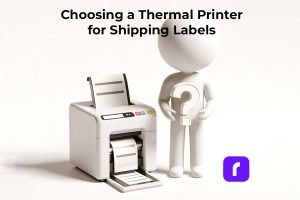
While you can print shipping labels using a regular printer, the level of your e-commerce ambitions should guide your choice. Occasional hobbyists may find inkjet or laser printers sufficient, but those looking to scale their business and save time should invest in a quality thermal label printer.
Transform Your E-Commerce Shipping with The Best Thermal Printer for Shipping Labels
Shipping your products should be a fun and rewarding experience, and Rollo can help you achieve that. Over 100,000 small businesses and entrepreneurs use Rollo label printers to save money and ship efficiently.
Rollo printers are ideal for shipping labels 4×6, and are compatible with multiple marketplaces such as Amazon, Etsy, eBay, and Shopify. Just like the inkjet and laser printers, Rollo’s thermal printer for shipping labels is compatible with all operating systems. Refurbished printers with a 6-month warranty are also available, minimizing your starting cost and doubling the eco-friendly impact of your business.
Benefits of Using Rollo’s Thermal Printer for Shipping Labels Your Shipping Labels
When it comes to shipping, efficiency is key. Rollo thermal printer for shipping labels not only provides high-quality, durable labels but also streamlines your shipping process. By using a thermal label printer, you’ll save time on printing, cutting, and taping, allowing you to focus on growing your e-commerce business.
| Benefits of Using Rollo’s Thermal Printer for Shipping Labels |
| ✔️User-friendly setup and integration: Integrate with various operating systems, marketplaces, and shipping carriers. |
| ✔️ Print fast and reliably. High-speed wireless or USB printing with AirPrint® enabled. |
| ✔️ Save time on printing, cutting, and taping labels. |
| ✔️ Inkless Printing – Save on Costs and Save the Environment |
| ✔️ Print Shipping, Barcode, or Brand Labels. |
| ✔️ Design your own labels. |
| ✔️ Discount options on shipping rates when using the Rollo Ship App. |
| ✔️ Reliable Customer Support. |
Why Choose Rollo’s Thermal Printer for Shipping Labels Over Regular Inkjet and Laser Printers
If you’re serious about growing your e-commerce business, it’s time to upgrade to Rollo’s cheap thermal printer for shipping labels. You’ll experience improved efficiency, cost savings, and professional-quality labels that will impress your customers and enhance your brand.
Don’t let outdated printing methods hold you back. Embrace the future of e-commerce shipping and join the thousands of entrepreneurs who have already discovered the benefits of our thermal printer for shipping labels and stickers. Get started today and watch your business soar.

✅ Boost Your Brand Image with Rollo Professional Labels
In the competitive world of e-commerce, your brand image is crucial. High-quality, durable, and professional-looking shipping labels can make a significant difference in how your customers perceive your business. With our thermal printer for shipping labels, you’ll be able to create labels that make your packages stand out, elevating your brand and leaving a lasting impression.
✅ Our Thermal Printer for Shipping Labels Offers Customizable Label Options
Our thermal printer for shipping labels bluetooth enabled or USB-connected, offers a variety of label sizes and materials to choose from, ensuring that your shipping labels always fit your packaging perfectly. With the flexibility to customize your labels, you can create a consistent and cohesive look for your brand.
✅ With Rollo You Have Improved Customer Experience
A professional-looking package not only reflects well on your brand but also enhances the customer experience. When customers receive a well-packaged item with a high-quality label, they’re more likely to trust your business and become repeat customers. If you decide to create your own custom labels, you can do so with the Rollo Design Tool. While regular free online design tools like Canva are very user and beginner-friendly, they are not customized for label sizes such as circular brand labels, barcode labels, or shipping labels.

Competitive
✅ Rollo Thermal Label Printer Makes You Competitive in the E-commerce World
In an ever-growing and highly competitive e-commerce landscape, standing out from the crowd is vital for success. Our thermal printer for shipping labels gives you that edge by offering numerous benefits that help your business shine. Let’s explore how Rollo’s thermal printer for shipping labels can transform your e-commerce operations and pave the way to a thriving business.
Efficient
✅ Increased Efficiency and Time Savings with Specialized Shipping Label Printer
Time is a valuable resource, especially for e-commerce entrepreneurs who juggle multiple tasks daily. With a thermal printer for shipping labels, you’ll save valuable time by eliminating the need for manual cutting and taping labels onto packages. The fast printing speeds also mean you can process more orders in less time, allowing you to handle increased order volumes during peak seasons or promotional events.
Deliverable
✅ Enhanced Shipping Accuracy by Minimizing the Risks and Errors
Shipping errors can be costly and damaging to your reputation. The thermal printer for shipping labels ensures that your labels are always clear and legible, minimizing the risk of shipping errors due to smudged ink or torn labels. By reducing the chance of shipping errors, you can maintain a high level of customer satisfaction and minimize the expenses associated with returns and reshipments.
Reputation
✅ Build a Strong Reputation for Quality and Reliability
A professional image is crucial for attracting new customers and retaining existing ones.
By using a thermal printer for shipping labels, you’ll consistently create HQ and durable labels
that reflect your commitment to excellence.
This attention to detail can lead to:
- increased customer loyalty
- positive reviews
- solid reputation for quality and reliability.
Recognition
✅ Embrace The Power of Customization for Your Brand Recognition
A strong brand identity is essential for standing out in a crowded marketplace.
The thermal printer for shipping labels offers a range of customization options, including various label sizes and materials, allowing you to create labels that align with your brand’s aesthetic. This consistency in your packaging and labeling helps create a memorable and easily recognizable brand identity.
Scalability
✅ Grow Your E-Commerce Business Now
As your e-commerce business expands, your shipping needs will evolve. Our thermal printer for shipping labels is designed to let your business grow, allowing you to handle increased order volumes without compromising on label quality or efficiency. The cost savings associated with using a thermal printer for shipping labels also become more significant as your shipping needs increase, ensuring that your business remains competitive and profitable.
Integration
✅ Integration of Rollo’s Thermal Printer for Shipping Labels with Popular Shipping Platforms
Our thermal printer for shipping labels integrates effortlessly with popular e-commerce platforms and shipping carriers, including Shopify, Etsy, eBay, Amazon, WooCommerce, Walmart, Wix, Magento, PayPal, UPS, FedEx, USPS, and more. This seamless integration simplifies the shipping process and ensures that your labels meet the requirements of your chosen carrier, reducing the likelihood of shipping issues or delays.
Expandable
✅ Rollo Helps You Expand into New Markets: Consider Targeting Sustainable Businesses
By streamlining your shipping process and providing professional, high-quality labels, our thermal printer for shipping labels can help you expand into new markets and customer segments. For instance, you may decide to target environmentally conscious consumers by highlighting your use of eco-friendly, FSC-certified labels. By catering to the preferences of specific market segments, you can broaden your customer base and increase sales.
Sustainable
✅ With Rollo You Are Building a Sustainable E-Commerce Business Yourself
In today’s environmentally conscious society, businesses that prioritize sustainability are more likely to succeed. The thermal printer for shipping labels supports your efforts to build an eco-friendly e-commerce business by using BPA-free labels and eliminating the need for ink or toner, reducing waste and environmental impact. By adopting sustainable business practices, you’ll appeal to a wider audience and contribute to a healthier planet.
Investment
✅ A Worthwhile Investment for Long-Term Success
Although the upfront cost of a thermal printer for shipping labels may be higher than a traditional inkjet or laser printer, the long-term benefits and cost savings make it a worthwhile investment. As your e-commerce business grows, you’ll appreciate the efficiency, time savings, and professional-quality labels provided by a Rollo printer. By investing in a thermal label printer, you’re setting your business up for long-term success and profitability.
Customer Support
✅ Rollo Has an Excellent Customer Support System
When you choose Rollo, you’re not just purchasing a high-quality thermal label printer; you’re also gaining access to a dedicated support team committed to your success. Rollo customer service team is available to answer any questions and provide guidance on using your thermal label printer, ensuring a smooth and enjoyable experience from setup to ongoing usage.
Look no further. Choose your Rollo Thermal Printer.
In Conclusion: Rollo Is Your Partner in E-Commerce Success
Embrace the future of e-commerce shipping and invest in a thermal printer for shipping labels today. With Rollo by your side, you’ll be well on your way to achieving e-commerce success and realizing your entrepreneurial dreams.
Follow Rollo on:
Frequently Asked Questions about The Thermal Printer for Shipping Labels
Q: What is the difference between a thermal printer for shipping labels and a regular inkjet or laser printer?
Short Answer:
| Printer Type | Supplies Used | Paper Type | Cost Efficiency | Overall Satisfaction |
| Inkjet Printers | Use Ink | Regular Paper | Cheap short-term, but unsuitable solution | 🙁 |
| Label Printers | Use Toner | More Expensive Paper | Cheap temporary, but unsuitable solution | 😐 |
| Thermal Printers | Inkless | Eco-friendly durable labels | Great for the long-term, saving money and time | 😊 |
Long Answer: The main difference between a thermal printer for shipping labels and a regular inkjet or laser printer is the printing technology. A thermal printer for shipping labels uses heat to print on specialized labels, eliminating the need for ink or toner, while inkjet and laser printers rely on ink or toner cartridges. Thermal printers offer more durable, smudge-free labels, cost savings over time, and improved efficiency.
Q: What labels should I use for my thermal printer?
Short answer: All labels are printed on heat-sensitive label paper, FSC-certified, and BPA-free.
| Label Sizes | |
| Shipping Labels | 4×6 inches |
| Barcode Labels | 2×1 inches |
| Circle Labels | 2 inches diameter (1 inch Core Size, 4 inches Outer Diameter) |
Long Answer: For your thermal printer, use labels specifically designed for thermal printing. These labels have a heat-sensitive coating that reacts to the printer’s heat, producing clear and durable prints. Rollo’s thermal printer for shipping labels is compatible with a variety of label sizes and materials, including eco-friendly, FSC-certified labels, providing flexibility and customization for your shipping needs.
